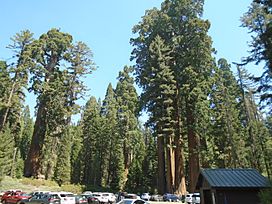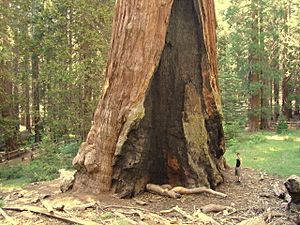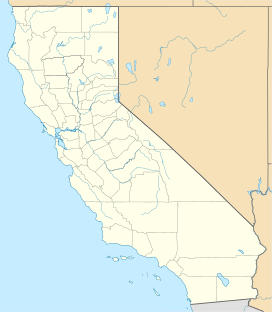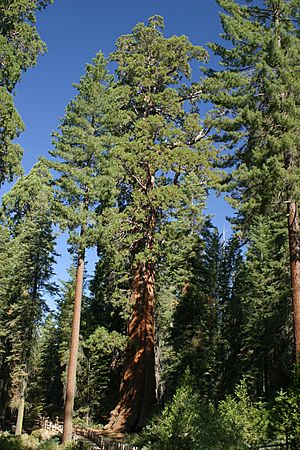General Grant Grove facts for kids
Quick facts for kids General Grant Grove |
|
|---|---|

General Grant Grove
|
|
| Map | |
| Geography | |
| Location | Kings Canyon National Park, California, United States |
| Coordinates | 36°44′48″N 118°58′33″W / 36.74667°N 118.97583°W |
| Elevation | 5,740–6,560 ft (1,750–2,000 m) |
| Ecology | |
| Dominant tree species | Sequoiadendron giganteum |
General Grant Grove is a special part of Kings Canyon National Park in California. The U.S. Congress created it in 1890. It's famous for its amazing giant sequoia trees.
The most famous tree here is the General Grant Tree. It's 267 feet tall, making it the third largest known tree on Earth! This tree is over 1,500 years old and is even called the United States' National Christmas Tree. General Grant Grove covers 154 acres and is a bit separate from the rest of Kings Canyon National Park.

Contents
Discovering General Grant Grove's Past
The first people to live in the area of General Grant Grove were Native American groups. These included the Monache, Tübatulabal, and Yokuts tribes. They spoke a language called Shoshonean.
In 1846, a miner named Hale Tharp was the first white settler to arrive. He wanted to start a cattle ranch. Tharp made a home inside a fallen sequoia tree. At first, the Native Americans welcomed him. He helped them hunt, and they lived together peacefully.
However, more settlers started coming to the area. The Native Americans began to get sick from diseases brought by the new arrivals. Tharp said the natives asked him to stop more settlers from coming. When he said it was impossible, they decided to leave the valley. By 1865, the native people had moved away. This left the area open for logging companies and cattle ranchers.
Protecting the Giant Trees: Park History
As more people came, conservationists (people who want to protect nature) started to worry. They wanted to save the giant trees. In 1873, a famous naturalist named John Muir hiked to the Giant Forest. After his trip, he began to push for the government to protect the area.
The giant sequoias were very valuable to loggers because they were so big and strong. A group called the Kaweah Colony even built the first road in the park to help with logging. But the government stepped in to protect the General Grant Tree. In 1880, they set aside four acres of land around the tree so it couldn't be sold or cut down.
Farmers in the nearby Central Valley also wanted the area protected. They were worried about how logging and sheep grazing were harming the land. These activities caused dirty water to run into their farms. They also feared losing the beautiful wilderness they enjoyed.
Because of pressure from farmers and conservationists like John Muir, Congress passed a bill. On October 1, 1890, Yosemite, Sequoia, and General Grant national parks were created.
Early Days of the Park and Challenges
In its early years, not many tourists visited General Grant National Park. They used the road built by the Kaweah Colony and stayed in tents. Later, better places to stay were built to attract more visitors.
At first, the State of California oversaw the park, and the U.S. Army protected it. The Army did a good job protecting the parks, even with limited money. In 1906, California gave control of the park to the federal government. Then, in 1916, the National Park Service was created. This new service took over managing the park permanently.
Even after the park was created, some private companies still wanted to use its resources. Officials from Los Angeles wanted to build dams on the Kings, Kern, and Kaweah rivers. They hoped to create hydroelectric power for the city. But local people were worried about the environmental impact of dams.
The Mt. Whitney Power Company started building power stations in 1898. They wanted to dam the rivers later. A law called the Federal Power Act in 1920 allowed companies to develop water projects on public lands. Los Angeles then tried to get permission to build dams inside and outside the park.
But people from the San Joaquin Valley strongly opposed the plan. After three years, Los Angeles' request to dam the rivers was denied. The fight to protect the rivers continued until 1965. By then, all of Kings Canyon was protected from hydroelectric development.
Kings Canyon National Park is Born
In 1940, General Grant Grove became part of the new Kings Canyon National Park. This happened thanks to Harold Ickes, the Secretary of the Interior, the Sierra Club, and Congress. Kings Canyon National Park included General Grant Grove and Kings Valley, which had not been protected before.
To get support for the park, Secretary Ickes asked a famous photographer, Ansel Adams, to take pictures of the area. Adams' beautiful photos helped convince Congress to create Kings Canyon National Park. General Grant Grove was then joined with it. Combining these areas helped the National Park Service better protect the sequoias in both places.
After World War II, the National Park Service started doing scientific research. The Leopold Report, published in 1963 by Dr. Starker Leopold, suggested returning wilderness areas to how they were when settlers first arrived. To do this, the report said parks needed scientists to study and care for the ecosystems.
In Sequoia and Kings Canyon, this report had an immediate effect. Scientists were hired to study human impacts on the Giant Forest. They also looked at overgrazing by deer and dangers to endangered species. By 1971, Kings Canyon had a chief scientist and other researchers. They worked to preserve the sequoias and gather information for the future.
By 1982, park officials noticed that the places for visitors in General Grant Grove were getting old. They wanted to improve the cabins to attract more people. The National Park Service made a plan to expand and improve the accommodations. They decided to build more units for tourists and make the existing ones better.
The old cabins of the Giant Forest Lodge Historic District were taken down between 1997 and 2000. This area was then returned to its natural state. In 2015, the Rough Fire burned through the northern part of the grove. It sadly killed 12 trees that were larger than 4 feet wide.
Climate in General Grant Grove
General Grant Grove has a warm-summer Mediterranean climate. This means it has dry summers that are warm during the day and cool at night. Winters are wet and cool, with lots of rain and snow. Nighttime temperatures often drop below freezing.
| Climate data for Grant Grove, California (normals 1981-2010, 2000-2020 extremes) | |||||||||||||
|---|---|---|---|---|---|---|---|---|---|---|---|---|---|
| Month | Jan | Feb | Mar | Apr | May | Jun | Jul | Aug | Sep | Oct | Nov | Dec | Year |
| Record high °F (°C) | 67.0 (19.4) |
69.0 (20.6) |
69.0 (20.6) |
75.0 (23.9) |
83.0 (28.3) |
90.0 (32.2) |
91.0 (32.8) |
90.0 (32.2) |
89.0 (31.7) |
82.0 (27.8) |
75.0 (23.9) |
70.0 (21.1) |
91.0 (32.8) |
| Mean maximum °F (°C) | 59.0 (15.0) |
59.0 (15.0) |
60.0 (15.6) |
67.0 (19.4) |
74.0 (23.3) |
80.0 (26.7) |
85.0 (29.4) |
85.0 (29.4) |
81.0 (27.2) |
73.0 (22.8) |
65.0 (18.3) |
59.0 (15.0) |
87.0 (30.6) |
| Mean daily maximum °F (°C) | 44.4 (6.9) |
44.2 (6.8) |
46.2 (7.9) |
50.3 (10.2) |
58.9 (14.9) |
68.8 (20.4) |
76.8 (24.9) |
76.6 (24.8) |
70.2 (21.2) |
60.3 (15.7) |
50.1 (10.1) |
44.2 (6.8) |
57.6 (14.2) |
| Daily mean °F (°C) | 35.4 (1.9) |
35.1 (1.7) |
36.9 (2.7) |
40.7 (4.8) |
48.6 (9.2) |
57.4 (14.1) |
64.7 (18.2) |
64.3 (17.9) |
58.6 (14.8) |
49.9 (9.9) |
40.8 (4.9) |
35.4 (1.9) |
47.3 (8.5) |
| Mean daily minimum °F (°C) | 26.3 (−3.2) |
25.9 (−3.4) |
27.6 (−2.4) |
31.0 (−0.6) |
38.3 (3.5) |
46.0 (7.8) |
52.7 (11.5) |
52.1 (11.2) |
47.0 (8.3) |
39.6 (4.2) |
31.5 (−0.3) |
26.6 (−3.0) |
37.1 (2.8) |
| Mean minimum °F (°C) | 12.0 (−11.1) |
13.0 (−10.6) |
14.0 (−10.0) |
18.0 (−7.8) |
25.0 (−3.9) |
32.0 (0.0) |
44.0 (6.7) |
42.0 (5.6) |
34.0 (1.1) |
27.0 (−2.8) |
18.0 (−7.8) |
13.0 (−10.6) |
8.0 (−13.3) |
| Record low °F (°C) | −6.0 (−21.1) |
−4.0 (−20.0) |
0.0 (−17.8) |
6.0 (−14.4) |
13.0 (−10.6) |
22.0 (−5.6) |
32.0 (0.0) |
27.0 (−2.8) |
21.0 (−6.1) |
11.0 (−11.7) |
8.0 (−13.3) |
−4.0 (−20.0) |
−6.0 (−21.1) |
| Average precipitation inches (mm) | 7.81 (198) |
7.33 (186) |
6.67 (169) |
3.65 (93) |
1.60 (41) |
0.53 (13) |
0.23 (5.8) |
0.13 (3.3) |
0.90 (23) |
2.47 (63) |
4.27 (108) |
6.67 (169) |
42.26 (1,073) |
| Average snowfall inches (cm) | 35.1 (89) |
38.7 (98) |
43.3 (110) |
16.3 (41) |
3.8 (9.7) |
0.4 (1.0) |
0.0 (0.0) |
0.0 (0.0) |
0.2 (0.51) |
3.1 (7.9) |
12.4 (31) |
26.7 (68) |
180.0 (457) |
| Average precipitation days (≥ 0.01 in) | 9.0 | 10.0 | 9.4 | 7.4 | 4.1 | 1.7 | 1.1 | 1.0 | 2.7 | 3.7 | 6.2 | 7.6 | 63.9 |
| Average snowy days (≥ 0.01) | 6.7 | 7.2 | 7.2 | 5.2 | 1.7 | 0.2 | 0.0 | 0.0 | 0.1 | 0.9 | 2.9 | 5.5 | 37.6 |
| Source: NOAA | |||||||||||||
Caring for the Environment: Challenges and Solutions
Protecting the Grove: Early Issues
Even when few people visited General Grant National Park, vandalism was a problem. Tourists often carved their names into trees or shot arrows into them. The General Grant Tree, being the largest, suffered the most. To stop this, the U.S. Army put fences around the main trees.
Another early problem was too many sheep grazing. Sheep ate too much, harming and killing plant species in the park. Army officials stopped this by removing ranchers and their sheep from the park.
Fire Management: A Changing Approach
How fires are managed has changed a lot over time. Today, General Grant Grove uses controlled burns. But in the early years, all fires were put out. This led to a lot of brush building up in the grove. Putting out all fires was common practice in the early 1900s.
However, regular fires are important for a forest's health. By stopping fires, the Army and California put the grove at risk of major habitat loss. Even when the National Park Service started in 1916, fire policies didn't change at first.
The Leopold Report later changed fire policy in Kings Canyon. Dr. Leopold used the sequoia groves as an example of why controlled burning was needed. The Wilderness Act of 1964 supported these findings. It said that national parks and forests, including Kings Canyon, should have controlled burns.
So, the National Park Service started using fire again as a natural process. This helps prevent too much brush from building up. By 1972, Kings Canyon had a plan for controlled burns across the whole park. Today, controlled burns are still a key part of how the National Park Service manages Kings Canyon and General Grant Grove.
Modern Threats: Air Pollution and Climate Change
Another growing concern for the Grove is air pollution caused by humans. National Park Service staff worry that greenhouse gas emissions are making temperatures rise. They believe these higher temperatures are already harming the park's habitats. Ozone pollution also affects how sequoia seedlings grow.
Research shows that climate change is already impacting Kings Canyon. The snow line is moving higher up the mountains. This means less water storage, changes in animal habitats, and more severe fires. Giant sequoias need specific conditions to grow. Climate change could cause them to lose their habitat. Fewer areas in the park might have the right conditions for sequoias to survive.
Specifically, warmer temperatures could stop new sequoias from growing. It could also lead to more trees dying from long droughts. Current plans aim to slow the effects of climate change. They focus on reducing air pollution inside the parks and in the larger San Joaquin Valley. Kings Canyon is a leader in this effort. But since climate change is mostly caused by human activity outside the park, air quality will remain a challenge. This is true even with the National Park Service's efforts to protect these ancient trees.
Visiting General Grant Grove Today
General Grant Grove has many sequoia trees located around a half-mile walking loop. Visitors can explore several trails, like the Big Stump Trail, Redwood Canyon Trail, and the Big Baldy Trail. The Panoramic Viewpoint offers amazing views of the entire grove. From this spot, hikers can see a lookout at 7,520 feet to the northeast.
Besides the General Grant Tree, which is a huge 270 feet tall and 107 feet around, there's also the Robert E. Lee tree. This impressive tree stands 254 feet tall and is the eleventh largest tree in the world.




